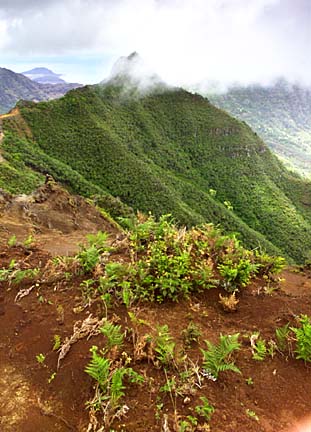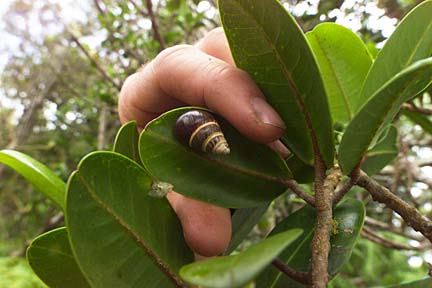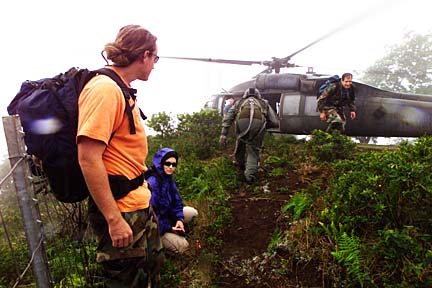


A safe haven ... At more than 2,800 feet above the valley floor Army natural resources specialists are helping to preserve the last known species of Hawaii tree snails that inhabit the Waianae Mountains.
or training ground?
Army works to preserve Makua
Valley's native speciesBy Gregg K. Kakesako
Star-BulletinOn a southern ridge overlooking Makua Valley, the Army is cultivating what its scientists describe as "the last vestige" for rare Hawaii plants and animals. The Army estimates that 90 percent of the world's population of eight endangered species live there. This place is called Ohikilolo ridge, which separates Makua and Waianae valleys.
"This is part of the Army's natural resource management programs endangered species to prevent don't go extinct," said Matthew Burt, one of several resource assistants who recently spent several days on the narrow ridgeline on quarterly field trips to monitor several special projects.
Makua Valley, now a battleground between environmentalists and some Hawaiian activists who want the land back, also is the home of at least 34 endangered plants, two endangered birds (Oahu creeper and Oahu elepaio), one endangered snail (Oahu tree snail) and one endangered bat (Hawaiian hoary bat).
While the Army wants to renew training in Makua using fewer soldiers and less powerful munitions, Earthjustice Legal Defense Fund, representing some Leeward Oahu residents, believe a more through environmental study is needed. Their request for a restraining order will be heard in federal court July 19.

Because Makua is the only live-fire maneuver training area on Oahu capable of training company-size units, the Army says its continual use is necessary to fulfill its critical readiness requirements.Only the southern part of the valley will be used in the training exercises where soldiers will fire weapons ranging from howitzers to rifles. The Pililau training complex takes up 457 acres of the 4,190 acres under the Army's control. Eliminated from the Army's training arsenal will be TOW missiles (tube-launched, optically-tracked, wire-guided anti-tank missile), incendiary munitions and tracer bullets.
Like all federal agencies, the Army is mandated by the Endangered Species Act to conserve protected species. Some Army officials say that partnering with other government agencies, such as the U.S. Fish and Wildlife Service, which administers the Endangered Species Act, helps the Army to be more effective in that area.
Vince Costello, Army natural resources assistant, said that almost all of the endangered plants and animals don't reside in the 457-acre training area located on the floor of the valley where all of the shooting will take place.
The majority of the endangered plants and animals live in the higher elevations and along the ridges that ring the valley.
However, despite a recent modified environmental assessment, which maintains that the Army's new training program will have no significant impact on Makua's environment, Costello acknowledges that the more than half century of dropping bombs, rocket firing and live ammunition firing "has had positive and negative affects on the plants and the snails."
The biggest threat has been fires.
Wildfires ignited by ricocheting ammunition such as tracer bullets, mortars or rockets have destroyed important nesting trees and burnt off natural habitats which was then replaced by alien weed species, Costello said.

In June 1995, a prescribed burn by the Army got out of control and destroyed 2,400 acres within Makua Valley and into the Kuaokala Game Management Area. Three years later on September 1998, a fire ignited by a mortar round started outside the firebreak and burned 800 acres.As a result of that fire the Army suspended training to investigate the fires and evaluate its management program and training procedures.
Makua Military Reservation has been under US Army jurisdiction for use as a training area since May 1943. In May 1988, the Army constructed a Company Combined Arms Assault Course, and actively used it for the next 10 years, firing everything from TOW missiles, rockets and howitzer shells.
No training has been held since then and the Army had wanted to restart its training cycle with a company of 150 soldiers and a ban on highly flammable ammunition earlier this year, but ran into opposition by some area residents and environmentalists.
However, Costello notes that the Army's environmental programs also "protected the natural qualities and beauty of the islands."
To do that the Army has spent $1 million over the past six years to erect 10 miles of fence along the Waianae ridges of Makua Valley to keep out feral pigs and goats, which next to fire are the greatest threat to endangered plants, Burt said.
And for the past three years Army natural resources specialists have tagged and monitored the growth of 400 endangered Oahu tree snails (Achatinella mustelina) which are only found in this one place on Oahu.
Costello said the trees where the tree snails are found are lettered and each thimble-sized snail is marked with a number. Unlike other species of snails that bear a thousand or so young at a time, Oahu tree snails only bear one to four offsprings a year, but live at least 20 years.
Ohikilolo management area
Location:
Ohikilolo ridge separating Waianae and Makua valleys
Size: 40 acres
Terrain: Steep and rocky
Access: Helicopter only
Characteristics: Habitat for 10 endangered plants and the largest population of Oahu tree snails.
Source: U.S. Army
Twenty trees in the 40-acre Ohikilolo ridge management area have been identified "where the tree snails proliferate," Costello said.
Army botanists, volunteers and equipment have to be flown in by a UH-60 Black Hawk, landing at a perch at the highest point of Ohikilolo just longer than the helicopter.
In other Makua management areas, Costello said rare island plants are cultivated and seeds from them also are taken for further study at the state nursery or other facilities like Lyon Arboretum. Young plants are marked with tiny colored pink or yellow flags.